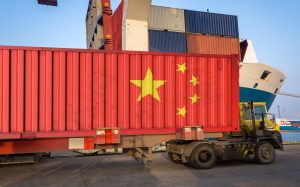China’s exports plunged by 14.5 percent in July compared with a year earlier, adding to pressure on the ruling Communist Party to reverse an economic slump.
Imports tumbled 12.4 percent, customs data showed Tuesday, in a blow to global exporters that look to China as one of the biggest markets for industrial materials, food, and consumer goods.
Exports fell to $281.8 billion as the decline accelerated from June’s 12.4 percent fall. Imports sank to $201.2 billion, widening from the previous month’s 6.8 percent contraction.
The country’s global trade surplus narrowed by 20.4 percent from a record high a year ago to $80.6 billion.
Chinese leaders are trying to shore up business and consumer activity after a rebound following the end of virus controls in December fizzled out earlier than expected.
Economic growth sank to 0.8 percent in the three months ending in June compared with the previous quarter, down from the January-March period’s 2.2 percent. That is the equivalent of 3.2 percent annual growth, which would be among China’s weakest in three decades.
Demand for Chinese exports cooled after the Federal Reserve and central banks in Europe and Asia started raising interest rates last year to combat inflation that was at multi-decade highs.
The export contraction was the biggest since the start of the COVID-19 pandemic in 2020, according to Capital Economics. It said the decline was due mostly to lower prices, while volumes of goods were above pre-pandemic levels.
“We expect exports to decline further over the coming months before bottoming out toward the end of the year,” said Capital Economics in a report. “The near-term outlook for consumer spending in developed economies remains challenging.”
The ruling party has promised measures to support entrepreneurs and to encourage home purchases and consumer spending but hasn’t announced large-scale stimulus spending or tax cuts. Forecasters expect those steps to revive demand for imports but say that will be gradual.
“Domestic demand continues to deteriorate,” said David Chao of Invesco in a report. “Policymakers have pledged further policy support, which could buoy household spending and lead to an improvement in import growth for the coming few months.”
Exports to the United States fell 23 percent from a year earlier to $42.3 billion while imports of American goods retreated 11.1 percent to $12 billion. China’s politically sensitive trade surplus with the United States narrowed by 27 percent to a still-robust $30.3 billion.
China’s imports from Russia, mostly oil and gas, narrowed by just under 0.1 percent from a year ago to $9.2 billion. Chinese purchases of Russian energy have swelled, helping to offset revenue lost to Western sanctions imposed to punish the Kremlin for its invasion of Ukraine.
China, which is friendly with Moscow but says it is neutral in the war, can buy Russian oil and gas without triggering Western sanctions. The United States and French officials cite evidence China is delivering goods with possible military uses to Russia but haven’t said whether that might trigger penalties against Chinese companies.
Exports to the 27-nation European Union slumped 39.5 percent from a year earlier to $42.4 billion while imports of European goods were off 44.1 percent at $23.3 billion. China’s trade surplus with the EU contracted by 32.7 percent to $19.1 billion.
For the first seven months of the year, Chinese exports were off 5 percent from the same period in 2022 at just over $1.9 trillion. Imports were down 7.6 percent at $1.4 trillion.

































